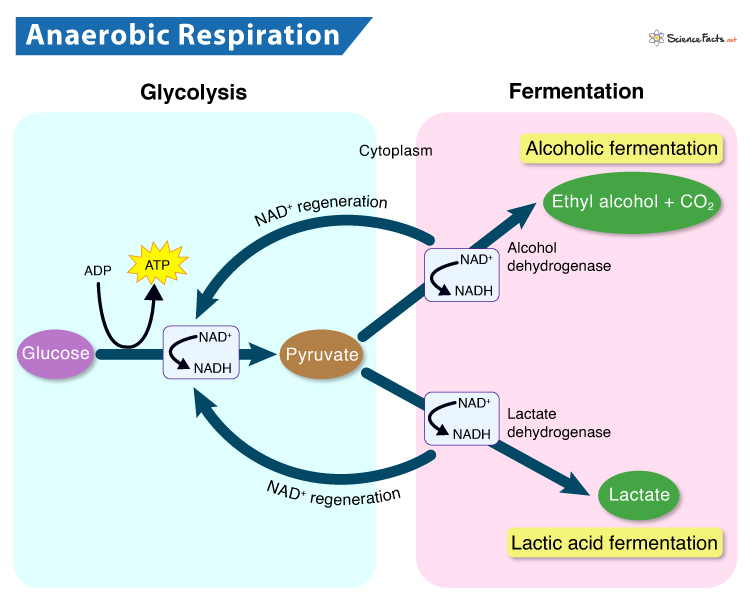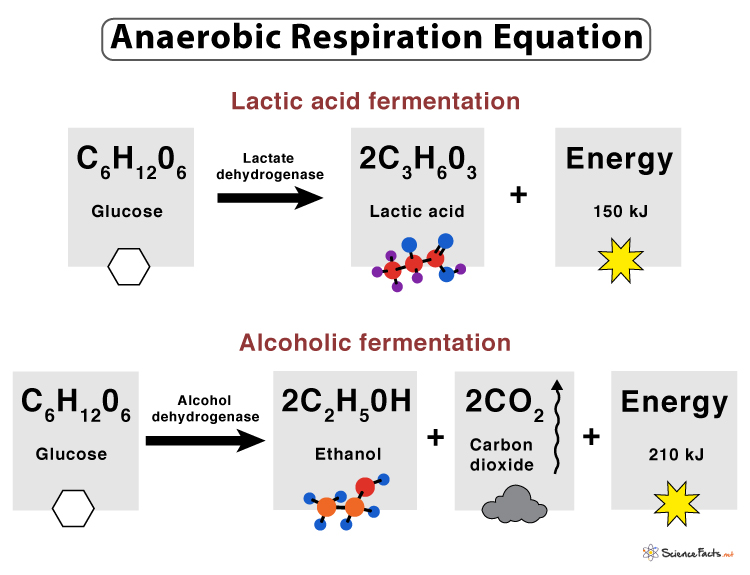Many microorganisms use nitrate (NO3–) and sulfate (SO42-) as electron acceptors, reduce it to nitrite (NO2–) and hydrogen sulfide (H2S) respectively. Anaerobic respiration exclusively occurs in the cell cytoplasm.
What Happens During Anaerobic Cellular Respiration
Types of Anaerobic Respiration
Advantages of Anaerobic Respiration
Steps of the Pathway
Anaerobic respiration occurs through two steps: glycolysis and fermentation.
1) Glycolysis
Glycolysis is the first and common step of cellular respiration. A glucose molecule splits into two pyruvate molecules, releasing electrons in the process and generating ATP. In this 10-step biochemical pathway, 4 ATP molecules are formed by substrate-level phosphorylation. Among them, two ATP molecules are used up during the initial steps. Hence, the net yield is 2 ATP per glucose molecule. Additionally, four electrons are released during the formation of NADH, which can be used to produce ATP by aerobic respiration.
2) Fermentation
Next, due to the absence of oxygen, the electron transport chain (ETC) fails to function as O2 is not present as the final electron acceptor. So, the pyruvate produced in the previous step cannot enter the mitochondria for aerobic respiration. As a result, there are an excess of NADH and pyruvate in the cytosol. As glycolysis is the only energy-yielding phase of anaerobic respiration, it needs to be repeated frequently to produce ATPs within a short period. Glycolysis runs ceaselessly if a continuous supply of NAD+ is available. To fulfill that demand, the NADH produced in the previous step donates its electrons to pyruvate and converts into NAD+, producing organic acid or alcohol as a byproduct. This phenomenon of producing acid or alcohol from pyruvate by the action of NADH is referred to as fermentation. How Many ATPs are Produced in Anaerobic Respiration In anaerobic respiration, 2 molecules of ATP are produced from 1 molecule of glucose.
1) Lactic acid Fermentation
In this process, NADH transfers its electrons directly to pyruvate, generating lactate as a byproduct. Lactate is just the deprotonated form of lactic acid, which gives the process its name. The lactate thus produced is cycled out of the cell and transported in the blood. A part of it goes to the liver and converts back to glucose during the Cori cycle. Glucose is essential for the cells. This type of fermentation is generally used in mammalian red blood cells and skeletal muscle with insufficient oxygen supply. Muscle cells use an enzyme called lactate dehydrogenase for this process.
Equation
2 CH3COCOOH + 4 NADH → 2 C3H6O3 + 4 NAD+ Reactants
Pyruvate (CH3COCOOH)Nicotinamide adenine dinucleotide (NADH)
End Products
Lactic Acid (C3H6O3)Nicotinamide adenine dinucleotide (NAD+)
2) Alcoholic Fermentation
In this process, NADH donates its electrons to a pyruvate derivative, producing ethanol in two steps. In the initial step, a carboxyl group is removed from pyruvate and released as carbon dioxide, producing a two-carbon molecule called acetaldehyde. In the second step, NADH passes its electrons to acetaldehyde, regenerating NAD+ and forming ethanol. This process is also called ethanol fermentation, as the final product of this reaction is ethanol. This process is conducted by microscopic organisms such as bacteria and some fungi such as yeast.
Equation
Step 1: CH3COCOOH → CH3CHO + CO2 Step 2: CH3CHO + NADH + H+ → C2H5OH + NAD+ Reactants
Pyruvate (CH3COCOOH)Nicotinamide adenine dinucleotide (NADH)
End Products
Acetaldehyde (CH3CHO)Ethanol (C2H5OH)Nicotinamide adenine dinucleotide (NAD+)Carbon dioxide (CO2)

